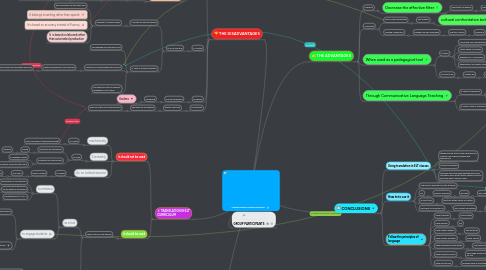
1. THE DISADVANTAGES
1.1. For students
1.1.1. It fosters bad habits
1.1.1.1. By thinking in L1 during talk or conversation
1.1.1.2. Hinders fluency in the L2
1.1.1.2.1. Ss see it as a fluid space, unstable and insecure.
1.1.2. It misleads them
1.1.2.1. because of
1.1.2.1.1. semantic differences
1.1.3. It creates a negative impact
1.1.3.1. since it is
1.1.3.1.1. more focused on
1.2. In context
1.2.1. it is not practical
1.2.1.1. it creates an artificial learning
1.2.1.1.1. because it is almost always
1.2.1.2. if used as a literal translation
1.2.1.2.1. The message and intention is lost
1.2.1.2.2. Culture is not usually taken into account
1.2.1.2.3. The semantic units of different languages do not match
1.3. In general
1.3.1. Can be considered
1.3.1.1. retrograde
1.3.1.1.1. Useless
1.4. For teachers
1.4.1. wastes class time
1.4.1.1. demands lots of planning
1.4.1.1.1. does not foster real communication
2. TRANSLATION IN ELT CURRICULUM
2.1. it should not be used
2.1.1. mechanically
2.1.1.1. to create
2.1.1.1.1. literal translations (meaning/meaning)
2.1.2. Constantly
2.1.2.1. to avoid
2.1.2.1.1. dictionary like expressions
2.1.2.1.2. Creating a dull environment
2.1.3. As an isolated exercise
2.1.3.1. it creates
2.1.3.1.1. empty content
2.2. it should be used
2.2.1. under control of the teacher
2.2.1.1. as a tool
2.2.1.1.1. to enhance
2.2.1.1.2. to engage students
2.2.1.2. As the "Fifth skill" of learning
2.2.1.2.1. integrating all other skills into practice
2.2.1.2.2. it seeks
2.2.1.2.3. it can be used to
3. BIBLIOGRAPHY
4. GROUP PARTICIPANTS
5. THE ADVANTAGES
5.1. it helps to
5.1.1. Decrease the affective filter
5.1.1.1. Helps with confidence
5.1.1.1.1. which results in
5.2. it aids with
5.2.1. cross cultural knowledge
5.2.1.1. and deepens
5.2.1.1.1. cultural confrontation between languages
5.2.2. creating connections
5.2.2.1. between the two languages
5.2.2.1.1. and two cultures
5.3. When used as a pedagogical tool
5.3.1. it fosters
5.3.1.1. Monitoring and comprehension of L2
5.3.1.2. Verbal agility in students
5.3.1.3. Expansion of L2 vocabulary
5.3.1.4. Development of sudents' styles
5.3.2. it proves to be
5.3.2.1. a useful aid
5.3.2.1.1. aimed at
5.4. Through Communicative Language Teaching
5.4.1. it regards language as
5.4.1.1. A social behavior
5.4.1.2. A purposeful action
5.4.1.3. Always in context
5.4.2. It offers a view of language learner as
5.4.2.1. a partner in learning
6. GROUP PARTICIPATION CHART
7. CONCLUSIONS
7.1. Using translation in ELT classes
7.1.1. teacher should have a clear objective and support from previous studies and experiences.
7.1.2. Conscious planning
7.1.3. Teachers should be aware that the exercise of translation as an action that is isolated is not an effective way to teach or learn.
7.2. How to to use it
7.2.1. It should be meaningful for the students.
7.2.2. For
7.2.2.1. specific purposes
7.2.2.1.1. through
7.2.3. In short times
7.2.3.1. must not be the center of a lesson
7.2.4. Must have a connection to
7.2.4.1. real context and setting
7.2.4.1.1. the other areas of knowledge.
7.3. Follow the principles of language
7.3.1. Never translate:
7.3.1.1. Demonstrate
7.3.2. Never explain:
7.3.2.1. Act
7.3.3. Never make a speech:
7.3.3.1. Ask questions
7.3.4. Never imitate mistakes:
7.3.4.1. Kindly correct
7.3.5. Never speak with single words:
7.3.5.1. Use sentences
7.3.6. Never speak too much:
7.3.6.1. Encourage students to speak for you
7.3.7. Never go too fast:
7.3.7.1. Keep the pace of the student

